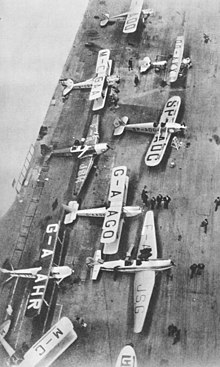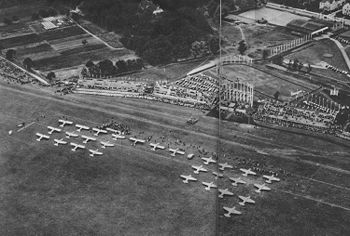Challenge International de Tourisme 1930
The flight across Europe 1930 ( also known as the Challenge 1930) was the second FAI International Travel Airplane Competition (French: Challenge International de Tourisme ). He started on July 18 and ended on August 8, 1930 in Berlin, Germany. Four competitions, 1929-1934, were great aviation events in Europe between the world wars.
Overview
Germany organized the competition, as the German pilot Fritz Morzik competition had won a year earlier ( flight across Europe, 1929 ). 60 aircraft took part in 1930. They came from six countries: Germany (30 crews ), Poland ( 12 crews ), United Kingdom (7 crews ), France ( 6 crews ), Spain ( 3 crews ) and Switzerland (2 crews ). It was the first major international event, which was attended by the Polish aviation. This time, the Italians were not there.
The German team was the first time Fritz Morzik - a winner of the Challenge 1929 in the British team, the pilots were: Captain Hubert Broad (2nd place 1929), the Canadian John Carberry (3rd place in 1929 ) and two women: Winifred Spooner and Lady. Mary Bailey. Many other well-known aeronaut this time took part in the competition.
The competition was opened on 16 July 1930 on the airport Berlin - Staaken. It consisted of two parts: a race across Europe and technical studies. Since one of the aims of the contest was to make progress in the design of the aircraft, it was not just a competition of the pilots, but also the technical studies as well as a production estimate to further build advanced jets. All aircraft flown by a two - man crew, pilot and passenger or mechanic.
Aircraft
Most of the aircraft in the competition were popular sports aircraft of the late 1920s, which also participated in the previous competition, such as the de Havilland Gipsy Moth DH -60G, which was the main aircraft of the British and Spanish teams. Most aircraft were open, low-wing, high-wing or biplane. Unlike the previous competition also some special planes were represented, which were better suited for the competition: the German BFW M.23c and terminal L 25E, new variants of the successful machines of 1929 - wooden low-wing monoplane and closed cockpit, with better opportunities in technical studies. All aircraft in the competition had a fixed landing gear and no mechanized wing ( leading edge slats or flaps ).
Participating aircraft types: BFW M.23c (10 ), BFW M.23b ( 1), Klemm L 25 ( 4), Klemm L 25E ( 3), Klemm L 26 ( 2), terminal VL 25 ( 1), Junkers A50 ( 3), Arado L II (4 ), Albatros L 100 ( 1), Albatros L 101 ( 1), Darmstadt D -18 ( 1) de Havilland Gipsy Moth DH -60G (6 ), Avro Avian ( 1), Spartan Guide (1) Monocoupe 90 (1), RWD 2 (3), RWD -4 ( 3), PZL.5 (2), PWS -50 ( 1), PWS -51 ( 1), PWS -52 ( 1), PWS -8 ( 1), Caudron C.193 ( 3), Caudron C.232 ( 1), Mauboussin 11 ( 1), Saint Hubert G1 ( 1), Breda Ba 15 ( 1), CASA C-1 (1).
The aircraft had alphanumeric starting numbers, German: A2- A9, B3 -B9, C1 - C9, D1 -D8, E1 -E9, F1 -F2, British: K1 -K8, French: L1- L3, M1 -M6, Polish: O1- O9, P1 -P5, Swiss: S1 and S2, Spanish: T1- T7 ( numbers were painted in a circle, with the inscription: Challenge International 1930).
Rally on Europe
The competition in 1930 was the only challenge, in which the rally was to start. It was a 7560 km rally over Europe. They went on: Berlin - Frankfurt am Main - St. Inglevert at Calais - Bristol - London - St. Inglevert - Paris - Pau - Zaragoza - Madrid - Sevilla - Zaragoza - Barcelona - Lyon - Munich - Vienna - Prague - Wroclaw - Poznan - Warsaw - Kaliningrad - Gdansk - Berlin. The regularity of flights was the most important factor, the second a cruising speed.
The rally started on July 20. On the first day reached the fastest teams St. Inglevert 1058 km away. On 21 July, the crews flew across the English Channel, and the fastest aircraft succeeded to return to France. Three Englishmen and three Frenchmen reached Paris still on the same day.
On 22 July, the fastest drivers Madrid, reaching 3019 km distance after the start. There were three Englishmen Hubert Broad, A. Butler (both DH -60G ) and Sidney Thom ( Avro Avian), John Carberry ( Monocoupe 90 ), three German (Fritz Morzik, Willy Polte - both BFW M.23c, Reinhold Poss - Terminal L 25E ) and two French ( Francis Arrachart, Maurice finite ). Three other teams flew to Zaragoza over the Pyrenees. The rest was distributed over the entire route, with the slowest drivers were removed only 800-1000 km from Berlin. Nine teams had already given up, especially due to glitches and crashes.
The eleven fastest teams were the lucky ones to reach Spain because on 23 and 24 July had, all the rest of the crews due to bad weather over the Pyrenees in Pauam remain bottom. On 25 July, the weather improved and the rest of the teams was allowed to fly to Zaragoza. Meanwhile reached the four fastest drivers ( Hubert Broad, Sidney Thorn, AS Butler and Reinhold Poss ) Wroclaw. Four teams gave up on that day, including the best Polish pilot Franciszek Żwirko with a RWD -4 ( due to engine failure ). On July 26, two German crew members, Erich Offermann and E. Jerzembski (BFW M.23c ) died in a crash landing in Lyon. A German crew fell into the sea, but was rescued by a ship (Rudolf Neininger, Darmstadt D -18).
On July 27, reached the first pilots Berlin. The first was Hubert Broad (DH -60G ), then Sidney Thorn ( Avro Avian) and a German, Reinhold Poss ( Klem L.25E ). Within an hour, landed Fritz Morzik (BFW M.23c ), Maurice finite ( Caudron 193), Prince Anton von Habsburg- Bourbon ( DH -60G ), Georg Pasewaldt, H. Andrews and AS Butler. The quickest around the track was A. S. Butler ( DH -60G - average speed 179 km / h ), but the replacement of a propeller in Poznan he was disqualified and finished the rally outside of the competition, was second fastest Hubert Broad (176 km / h). On this day 35 teams were still on the road. On July 28, after seven other teams Berlin, July 29, nine more, and the rest - the next day. The last team finished the rally on August 1. Some crews still showed up in the last days.
The rally across Europe appeared relatively difficult for aircraft and pilots. Only 35 of the 60 crews made it into the allotted time. Another seven teams finished the rally, but were disqualified due to delay or repairs. After the rally was the lead in the general classification Hubert Broad (DH -60G, 270 points), behind him followed: John Carberry ( Monocoupe 90, 268 points ), Reinhold Poss (terminal L.25E, 264 points). The fourth was Fritz Morzik (BFW M.23c, 263 points). Seventh was Winifred Spooner (260 points). The best Swiss team ended up in 13th place, the best poles, Stanisław Plonczynski, ended up in 14th place (RWD -2, 236 points).
Tests
On August 1, a technical evaluation of the competing aircraft took place. Since it was a competition between the jets, it came to features like comfortable cabins, number of displays and dual controls, safety devices (anti- fire devices and places for parachutes ) and folding wings were also excellent. In the technical evaluation reached the best 104 of a total of 230 possible points. The most important feature was a comfort cab ( up to 42 points). Most of the points reached the American Monocoupe 90 by John Carberry (74 points), followed by three German Junkers A50 with 67-69 points. 62 points reached the terminal L 25E of Reinhold Poss, level on points was the Polish RWD -4 by Jerzy Bajan. The DH -60G of Hubert Broad reached only 56 points, the BFW M.23c of Fritz Morzik 54 points. The second worst rating was that of Sidney Thoms Avro Avian - 43 points ( due to the lack of the folding wings ).
The next passage was followed by the rapid wing folds, a function to save space in hangars. The fastest were the British crews who flew the DH -60 ( Hubert Broad's crew took only 48 sec ), but the Germans got six extra points for their type of folding, therefore, received the BFW M.23c the most points (24 points). John Carberrys Monocoupe and Polish RWDS were disadvantaged because they did not have folding wings.
Next, there was the quick launch tests of aircraft engines and on August 3, a fuel consumption test at a distance of 304 km. The best fuel economy had the RWD -2s (which received 30 points ), then came German Klemm and BFWs.
According to these passages, the Germans led to the classification: Reinhold Poss ( 382 points), Oskar Notz (380 points ), Fritz Morzik ( 378 points ). Only then followed John Carberry ( 377 points ), Hubert Broad (375 points) and Winifred Spooner (370 points).
On August 6 and 7, there was a short start-up test. It was necessary to fly over a 8.5 meter high gate with a rope. Each team had four attempts. The German pilot Ernst Krüger was the best, with the lowest distance of 125.5 meters, then Fritz Morzik ( 126.4 meters ) - both flew BFW M 23c and have been awarded with 30 points. The nearest places also went to German. Sixth was Winifred Spooner, a DH -60 flew (142 meters - 25 points).
Lastly, followed by a passage for the shortest landing over a 8.5 meter high gate. The best result, 127.3 meters, reached the German Theo Osterkamp, he flew an older model of the terminal L.25 Ia, then followed Friedrich Siebel ( Klemm L 26). The third was Winifred Spooner (21 points); Fritz Morzik and Reinhold Poss reached the 5th and 6th place.
Results
In the test of the shortest landing on August 8, the closing ceremony was followed. The first three places were occupied by Germans. The winner was again Fritz Morzik. In the fourth place followed Miss Winifred Spooner, who could improve their position in technical passages, so after the rally on Europe.
Only 35 of 60 teams reached the end of the contest, including 20 German, 6 British, 4 Polish, 2 Swiss, 2 French teams and a Spanish team.
Due to the victory of the Germans, the next Challenge was held in 1932 in Germany. This next challenge was to prove by changes in the rules to be more difficult. For the competition in 1932, most countries developed advanced light aircraft with high technical performance.










